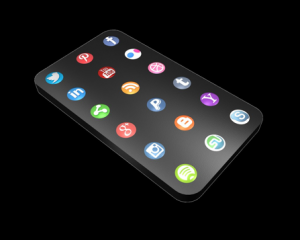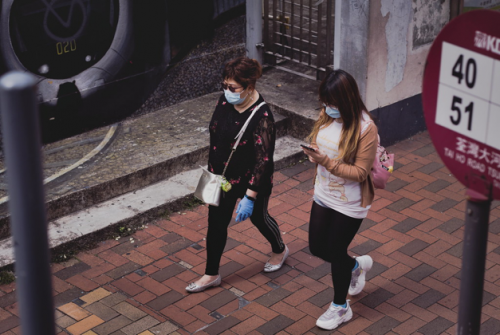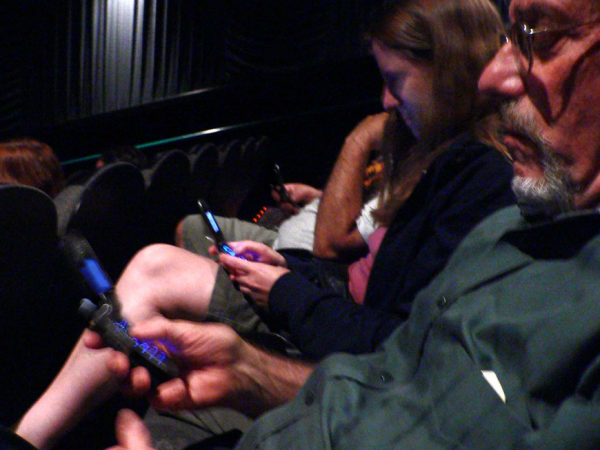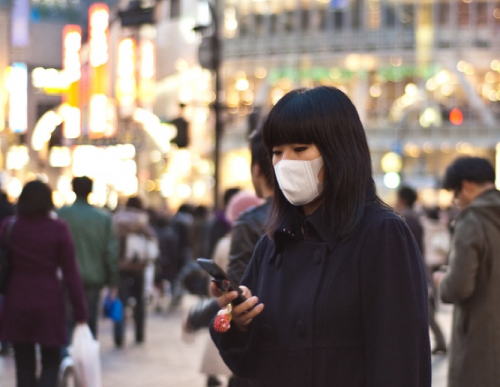7 Social Media and the Internet’s Effect on the Perceptions of the COVID-19 Pandemic
Josie Hartings
Introduction – Media, the Internet, and their Effects on Perception
Social media is more readily accessible than ever before. People can access the internet by the tap of a button. The web has a vast amount of information, which can be used as a great resource. However, anyone can post on these platforms, thus resulting in the spread of misinformation. The different information that is circling around the internet has caused society to have a range of perceptions with regards to the Coronavirus.
Based on which news sources one reads, there are varying levels of concern about this global pandemic. Science and technology within society are both key elements in communication and the way the public perceives the pandemic. Science has allowed us to create the technology that allows information to be so easily accessible to society. The media and internet both influence public opinion and perceptions of the COVID-19 pandemic by spreading misinformation, not fact-checking information, and taking advantage of a widespread susceptible audience.
Connection to STS Theory – Tragedy of the Commons
Several STS theories can be found when looking at communication and public relations. The perception of COVID-19 is different than the reality of this virus. An STS theory that is evident from this topic is Tragedy of the Commons. This is when humans and technology are not aligned with nature. For example, the fake news about COVID-19 is all over social media. People are making up statistics and giving people advice about what they should do to help. These claims are not coming from doctors or even medical professionals. Nature is what we should be following, not having people insert opinions and tell people what to do without the credentials to make those statements.
Tragedy of the Commons also involves humans working towards personal goals, thus disrupting nature. This is evident with the accuracy of information and people trying achieve other goals outside of just informing society. A third factor of this theory is humans’ inability to work towards a collective good when using technology. As society develops, it has shifted towards a technology based society. Unfortunately, this is driving society apart. People are less cohesive, thus having more dependency on technology for information. This is where the consistent truthful information ultimately suffers.
What is Misinformation and How is it Spread?
Before discussing exactly how the internet and media have impacted perceptions of COVID-19, one must understand the concept of misinformation. Misinformation is defined as, “false or inaccurate information, especially that which is deliberately intended to deceive.” (“Misinformation“) News, social media, and the internet all have issues with this. Being able to identify fake information is essential to one’s understanding of many topics in society.
Reliable information will come from places such as educated individuals and peer-reviewed articles. Reading a random post on social media is not the best basis on which we should base our beliefs. Check the source and the author before believing information. Some questions to ask include – Were they qualified to write this piece? What is their background? On what information is their research and statements based? Going through a few simple questions such as these will avoid being misinformed without knowing it.
The news and media have specific motives behind the information they spread. The spread of misinformation is easy on platforms such as Facebook, Twitter, and other social media sites (Gordon & McPhetres). The general problem with social media is that anyone can post on these sites. It is difficulty to fact-check all the information that is being used to inform the public. One tweet can get thousands of retweets even when the information is not true. The same problem lies within the general internet. People can post anything online. For example, when one searches “Coronavirus” on google, approximately 2,900,000,000 results come up in less than one second. The number of search results is growing by the day. People have over two-billion different result from which they can get information about the pandemic. Millions of people post about this virus, when they have no qualifications to do so, and this is all possible because of the internet.

The internet is the best way to spread information. Society saw the first real birth of the internet in the 1980s. This was initially invented for military use and their communication (Brief). They would communicate between bases and other locations while trying to protect the country. After a short time, the internet expanded to be a form of communication for scientists. Researchers were spread out all across the country. The internet was an effective tool in allowing scientists to problem solve together without traveling (Brief). This was a big step in the world of research and science. As technology within society has grown, people now have ways to access the internet in their pockets. Society revolves around this online connection and is the reason we can communicate quickly and over vast amounts of area. The internet is great for quick access, reporting, and as a source of information. However, we got into trouble when people use the power of the internet to taint opinions and spread misinformation.
In addition to the internet, the media has also become a large factor in the spread of information is society. The media is almost fully electronic and over the internet this day in age. The idea of the media started around the 1920s and soon became known as “mass media” within print form before the Second World War. During this time radio was developed and greatly impacted the way society received news. After the radio, video and television were invented. They soon became a key item in society and every average American family had a television in their home. This led to television media and news becoming more widespread. The world has moved away from paper news and now depends on the internet and news media for their information.
Spread of Pandemic Information
The news and social media are a root of the problem with varying perceptions of the pandemic. Harvard University did a study to find out more about how media influence has effected behaviors of society and people’s responses to Coronavirus. They posed the following questions –
- Did the type of media one is exposed to influence social distancing behaviors and beliefs about COVID-19?
- Is there a link between COVID-19 misinformation and perceptions of the pandemic’s severity and compliance with social distancing regulations?
The study used Twitter and tweets surrounding COVID-19 for most of their research. It found that the majority of information contained in these tweets about the pandemic are false. In addition, the study noted that over 47% of people have admitted to believing something they read on Twitter about Coronavirus (Pazzanese).
Researchers from Harvard also found that the answer to their first question is, yes. When people are exposed to news sources such as social media and unchecked information, they are more likely to believe false claims (Pazzanese). Most of the time, people are not even able to differentiate between what information is real and fake with regards to the pandemic. This is a new time for everyone. There is information coming from all different angles. How does one know what to believe? There are so many places to get information, so it is hard to know what is correct. This is why society has so many different opinions on the pandemic.
The same researchers also studied the contrast of Twitter and real news. The study looked at topics such as COVID-19 conspiracy, hygiene, social distancing, and those who claim it is no worse than the flu. The study found that misinformation was comparatively worse for all topics on Twitter (Bridgman). Topics such as personal hygiene and problem solving aspects of COVID-19 were much more common on the news. Twitter was found to have statistics with false numbers and dramatization of the pandemic. 50% of Twitter news on these topics is false. The news and other reliable news outlets were trying to help people frame a mindset while social media was full of false facts (Bridgman).

A third part of the Harvard study found a correlation between the spread of information and offline exposure. As seen in the previous two studies, one can see that social media news is not reliable. However, if people get information through offline exposure such as word of mouth, etc. if is less likely to be false. One would think that word of mouth would be a risky way to understand information, but Harvard found this form of fact sharing is actually more reliable than Twitter (Bridgman).
These trends in Harvard’s data makes it evident that the more exposure one has to social media, the more likely they are to have misinformation about the COVID-19 pandemic. When reading information on social media, people believe what they read. They don’t understand how to differentiate between true facts and false information. This is especially apparent with regards to the COVID-19 pandemic. Limiting one’s online exposure to fake news is key to understanding the truths behind the pandemic. When trying to understand this time in history, one should talk to educated individuals in the field and read peer-reviewed information. This will set one up for understanding and the ability to differentiate between what to believe.
Evaluating Information
In March 2020 a study conducted by researchers from MIT and other institutions investigated people’s ability to differentiate between real and fake news. 1,000 individuals were asked, “to the best of your knowledge, is the claim in the above headline accurate?” They were then asked, “would you share the above headline?” At first, researchers thought that people would be able to differentiate at least a few of the headlines, such as “Coconut oil’s history in destroying viruses, including Coronaviruses” and “Vitamin C protects against Coronavirus” because they seemed almost too crazy to be true. However, people ended up believing them. Out of all the headlines, the 1,000 individuals were only able to differentiate between 50% of the headlines (Gordon et al.). To put this into perspective, if half of what people are willing to believe with regards to headlines is fake, there is a problem. We cannot have people believing 50% fake information.
Another problem to take a look at is why exactly people spread this fake news. Sage research journal claimed that people are not intentionally trying to “misinform” the public (Gordon et al.). When people post, they are trying to achieve certain political goals. This is where the accuracy of information suffers. People focus their information on other factors that do not include accuracy. This is what is negatively effecting people’s perceptions of COVID-19. For example, some people did not agree with the way President Trump handled the effects of Coronavirus on the United States. People would shape their social media and news information to frame the Republican party in a bad way. They are not necessarily interested in informing people about Coronavirus, but rather to show the lack of Republican party competence with regards to the spread of COVID-19. Accuracy suffers because of motives such as these.
The Rise of Social Media
The spread of misinformation with regards to COVID-19 in society is not always because of big news media companies. They do their fair share of spreading inaccurate information, but social media usage rates are also to blame. In the last ten years, social media usage has increased every year. The world is has become more tech driven than ever. It is estimated that 3.96 billion people in the world use social media. Last year alone saw a 10.5% rise in usage (Snyder). If more people are getting connected online every year, then there is a wider audience every year. If people want to make something known, they need to get it out on the internet. The internet has become a widespread audience, and people with specific motives are taking advantage of it.

Society even sees children getting cell phones at increasingly young ages. They have social media accounts starting at a very young age. When older generations were young, social media didn’t exist. Times are changing and news/social medias are targeting children and their susceptible nature. Children are not always educated in how they can decipher between accurate and inaccurate information. This increase in social media usage and the increase in child use of social media is partly to blame for the spread of misinformation and fake news (Neubaum & Krämer).
The Harvard Gazette and other researchers are calling this time in history a, “pandemic of misinformation.” Throughout the last few months, people have looked to the internet for their information about Coronavirus (Tasnium et al.). People knew nothing about this virus in March of this year, but now it is all we talk about. Social media platforms have made this information readily available and at people’s fingertips. They don’t know where else to get information, so they go online, and often to social media – which is bad more often than not.

Social media and news companies with certain motives are also creating a problem for public health officials. The officials are having to work even harder to get their accurate information to the public. They are competing with information that is not even true. Lee Kum Kee, a Professor of Health Communication at the Harvard T.H. Chan School of Public Health, said this pandemic of misinformation is, “making our work a bit more difficult” (Pazzanese). Public health officials are having to work overtime in order to get people accurate information. This obstacle social media and news companies are creating is helping nobody in the long run (Ahmad & Hersh). Society needs to focus on the information that is backed up by facts and coming from public health officials. This is the only way everyone will be on the same page and the only way we can work towards a solution together.

Conclusion
Social media influences public opinion and perceptions of the COVID-19 pandemic by spreading misinformation, not fact-checking information, and taking advantage of the widespread susceptible audience. Having technology in the hands of everyone – including young children, makes them a target. They are naive and do not know when information is wrong. For example, when spam emails and text messages are sent to children, they often believe them. This is not because they want to be involved with spam, they just do not know it is bad. In addition, most people are getting information from the wrong sources. Twitter and Facebook are not reliable sources for information, especially with something as dangerous and new as COVID-19. Overall, people need to be careful about where they are getting information. Learning the wrong facts could cause more harm than good.
References
Ahmad, Araz Ramazan, and Hersh Rasool Murad. “The Impact of Social Media on Panic During the COVID-19 Pandemic in Iraqi Kurdistan: Online Questionnaire Study.” Journal of Medical Internet Research, vol. 22, no. 5, 2020, www.ncbi.nlm.nih.gov/pmc/articles/PMC7238863.
Bridgman, Aengus, et al. “The Causes and Consequences of COVID-19 Misperceptions: Understanding the Role of News and Social Media: HKS Misinformation Review.” Misinformation Review, 1 Sept. 2020, misinforeview.hks.harvard.edu/article/the-causes-and-consequences-of-covid-19-misperceptions-understanding-the-role-of-news-and-social-media/.
“Misinformation.” Lexico, https://www.lexico.com/en/definition/misinformation.
Neubaum, German, and Nicole C. Krämer. “Monitoring the Opinion of the Crowd: Psychological Mechanisms Underlying Public Opinion Perceptions on Social Media.” Media Psychology, vol. 20, no. 3, 2017, pp. 502-531, www.tandfonline.com/doi/full/10.1080/15213269.2016.1211539.
Pazzanese, Christina. “Social Media Used to Spread, Create COVID-19 Falsehoods. The Harvard Gazette, 8 May 2020, news.harvard.edu/gazette/story/2020/05/social-media-used-to-spread-create-covid-19-falsehoods/.
Pennycook, Gordon et al. “Fighting COVID-19 Misinformation on Social Media: Experimental Evidence for a Scalable Accuracy-Nudge Intervention.” Psychological Science. vol. 31, no. 7, 2020, pp. 770–780 SAGE Journals, journals.sagepub.com/doi/full/10.1177/0956797620939054.
Snyder, Victor. “How COVID-19 Has Changed Social Media Habits.” Business.com, 10 Aug. 2020, www.business.com/articles/social-media-patterns-during-the-pandemic/.
Stephanie Kulke. Social Media Contributes to Misinformation about COVID-19, Northwestern, 23 Sept. 2020, news.northwestern.edu/stories/2020/09/social-media-contributes-to-misinformation-about-covid-19/.
Tasnim, Samia, et al. “Impact of Rumors and Misinformation on COVID-19 in Social Media.” Journal of Preventive Medicine and Public Health, vol. 53, no. 3, 2020, pp. 171-174, www.ncbi.nlm.nih.gov/pmc/articles/PMC7280809/.
Images
“Social Media Remote” by Shahid Abdullah is in the Public Domain
“All People Wear Masks” by Stranofly is licensed under CC BY-NC-SA 4.0
“Cellphone Use Linked to Selfish Behavior in UMD Study” by Merrill College of Journalism Press Releases is licensed under CC BY-NC 4.0
“Family Togetherness” by Bev Sykes is licensed under CC BY 4.0
“Call Masking” by David Shackelford is licensed under CC BY-NC 4.0

